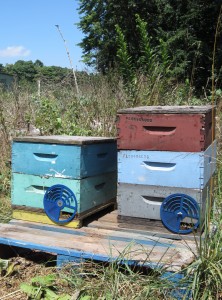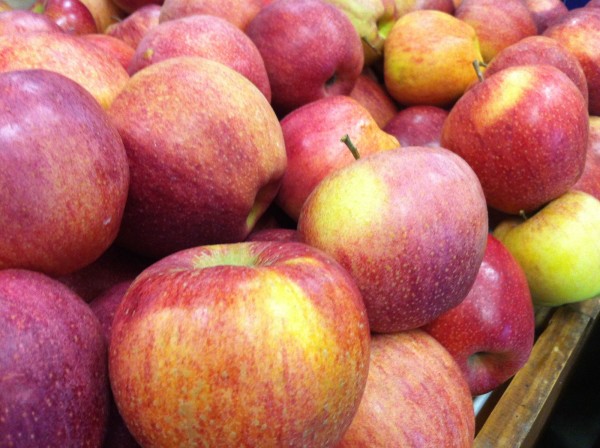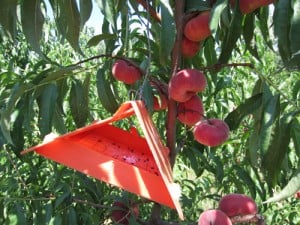“An apple a day keeps the doctor away.”
Or does it? A recent study published by the Environmental Working Group called “The Dirty Dozen,” has many people wondering just what they should be eating. The report ranked fruits and vegetables based on the levels of pesticides present in the produce and recommended eating organic versions of these items. I’ve read several articles on the issue, and wanted to share some of my thoughts.
The articles and research left me feeling like I only had two options when shopping for food: organic or conventional. They didn’t allow for anything in between, like our farm’s “integrated pest management” or IPM approach. When you shop at the grocery store, you do have to rely on the claims on the packaging, either made by the food producer or by the USDA labeling. When you shop directly from a farm like ours, you can ask us about our farming practices!
Insect trapping to monitor their movement in our orchard
Being an IPM farm means that we primarily try to avoid using pesticides in favor of more natural options. We regularly implement a variety of methods, including keeping the orchard mowed to reduce the habitat for harmful insects and disrupting the mating cycle of harmful insects. We also create habitats for beneficial and pollinating insects.
It is very difficult to be a truly organic orchard in our region, and we’ve seen many organic farms go out of business. Sometimes we need to use sprays to avoid losing a crop. Reasons for this include high populations of harmful insects, weather conditions causing sunburn on the skin of the fruit, rot (fungus, bacteria) or a disease detected in one crop that could spread to other crops. Keep in mind too, that organic does not mean it has not been sprayed, as theUSDA allows about 100 chemicals (about half of which are synthetic) in organic agricultural production and handling.
We make sure that we adhere strictly to all label restrictions on timing of pesticide application in terms of the length of time before we can harvest it and how it affects other insects. If there is an organic spray we can use, we will weigh the benefits of using it. One organic spray we use is calcium based to prevent our apples from sunburn. Often though, organic compounds require larger dosages and can actually harm beneficial insects more than some of the non-organic materials. For all of our crops, we start with the smallest needed application and monitor its effectiveness.
The report noted that even organic produce studied had some pesticide residue present. There are two main reasons for this. This is because some pesticides are allowed in organic farming, and every country has its own organic standards.
The Dirty Dozen study included both foreign and domestic produce. When organic produce comes here from other countries, the USDA uses what they call the “Equivalence Agreement.” According to their website, this is an “agreement between two countries allowing products that are produced and certified according to one country’s organic standards to be sold and represented as organic in the other country.” The bottom line: organic products from other countries are given the USDA organic label even if their standards are not exactly the same.
When talking with Justin Weaver, our fourth generation production manager about our farming practices, he said: “I don’t like to spray chemicals, especially for insects if I don’t absolutely have to. One reason is that I have to be around those chemicals too!” He explained to me that we do not spray on a schedule, like many conventional farms and even some organic farms. We monitor all of our crops intently, looking for signs of disease, mold and insect presence.

Honeybee hives in our orchard to encourage pollination.
Many of the pesticides we use have very low toxicity and are targeted very specifically for one insect and are safe for beneficial insects. “For example,” Justin explained, “this spring strawberries received only one insecticide but multiple fungicides due to all of the rain. Fungicides and bactericides are very low toxicity because they hinder fungus and bacteria from multiplying on the fruit or leaves of the trees, but they are not killing living creatures.”
Any residue seen on fruit is typically a result of fungicides and bactericides. The sun and rain break them down over time, but washing the fruit will remove any bacteria and dissolve any residue. It is always a good idea to wash fruits and vegetables before you eat them. Washing them in a mixture of 1/4 vinegar and 3/4 water removes 98% of bacteria from foods. Keep this mixture in a spray bottle by your sink for easy access.
If you are really concerned about overexposure to pesticides, the best thing to do is to eat a variety of foods including fresh fruits and vegetables. The outcome I fear the most from this report is that people will avoid fresh produce in favor of processed foods. The danger in this is that eating from limited crops will only offer limited nutritional benefits and expose you to greater numbers of the same pesticides.
“If the choice is between a bag of potato chips and a conventional apple, we advise consumers to go with the apple every time. The health benefits of a diet rich in fruits and vegetables outweigh the risks of pesticide exposure,” said Sara Sciammacco, of the Environmental Working Group who conducted the Dirty Dozen study.
The benefit of eating fresh fruits and vegetables far outweighs the potential negative impacts. Local produce is much fresher than produce found in the grocery store, which travels an average of 1500 miles before it gets to your plate. The nutritional quality of produce diminishes after food is harvested, so I always opt for in-season local produce in favor of organic produce.


